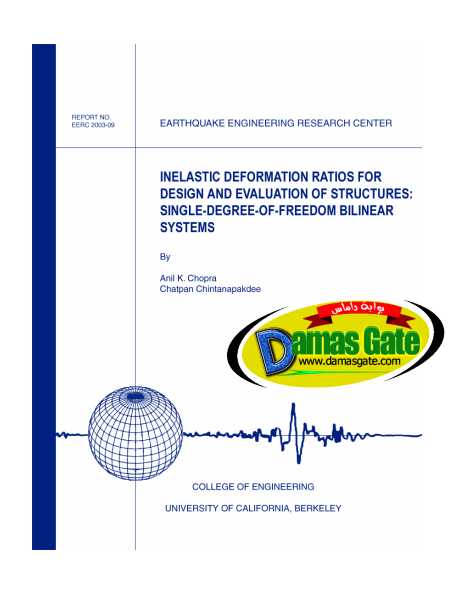Inelastic deformation ratios for design and evaluation of structures

Inelastic Deformation Ratios for Design and Evaluation of Structures: Single-Degree-of-
Freedom Bilinear Systems
By
Anil K. Chopra
And
Chatpan Chintanapakdee
A Report on Research Conducted Under Grant No. CMS-9812531 from the National Science Foundation
Earthquake Engineering Research Center University of California, Berkeley
December, 2003
© UCB/EERC 2003-09
1. INTRODUCTION
Current structural engineering practice usually estimates seismic demands by applying the nonlinear static procedure (NSP) or pushover analysis presented in FEMA273 [1997], FEMA356 [2000] or ATC-40 guidelines [1996]. Seismic demands are computed by nonlinear static analysis of the structure subjected to monotonically increasing forces until a predetermined target displacement is reached. More recently, a modal pushover analysis procedure based on structural dynamics theory has been developed [Chopra and Goel, 2002], where seismic demands due to individual terms in the modal expansion of the effective earthquake forces are determined by a pushover analysis using the inertia force distributions associated with each mode up to a “modal” target displacement. The target roof displacement in all of these pushover procedures is determined from the peak deformation of an inelastic single-degree-of-freedom (SDF) system with its force-deformation relation defined from the pushover curve. This has led to renewed interest in the relationship between the peak deformations of inelastic and corresponding linear
SDF systems, u and mu , respectively, a problem first studied by Veletsos and Newmark [1960]. o
Freedom Bilinear Systems
By
Anil K. Chopra
And
Chatpan Chintanapakdee
A Report on Research Conducted Under Grant No. CMS-9812531 from the National Science Foundation
Earthquake Engineering Research Center University of California, Berkeley
December, 2003
© UCB/EERC 2003-09
1. INTRODUCTION
Current structural engineering practice usually estimates seismic demands by applying the nonlinear static procedure (NSP) or pushover analysis presented in FEMA273 [1997], FEMA356 [2000] or ATC-40 guidelines [1996]. Seismic demands are computed by nonlinear static analysis of the structure subjected to monotonically increasing forces until a predetermined target displacement is reached. More recently, a modal pushover analysis procedure based on structural dynamics theory has been developed [Chopra and Goel, 2002], where seismic demands due to individual terms in the modal expansion of the effective earthquake forces are determined by a pushover analysis using the inertia force distributions associated with each mode up to a “modal” target displacement. The target roof displacement in all of these pushover procedures is determined from the peak deformation of an inelastic single-degree-of-freedom (SDF) system with its force-deformation relation defined from the pushover curve. This has led to renewed interest in the relationship between the peak deformations of inelastic and corresponding linear
SDF systems, u and mu , respectively, a problem first studied by Veletsos and Newmark [1960]. o
Download
*